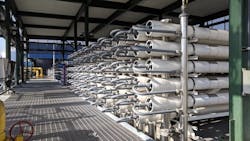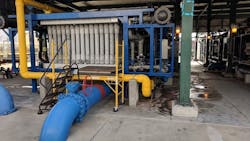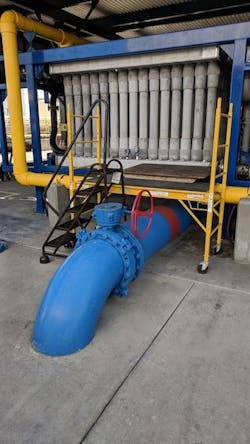Desalination of Seawater & Brackish Water
Wil Pergande is vice president of special projects for Osmonics, Inc., a manufacturer and worldwide marketer of high-technology water purification and fluid filtration, separation and handling equipment. He offers more than 30 years experience in management, sales and marketing in the water treatment industry. He may be reached at 612-933-2277. Barry Abolmaali is the manager of applications engineering and customer service at Osmonics, Inc., Vista Operations. He has utilized his chemical engineering degree at Osmonics for eight years. He may be reached at 760-598-1800.
undefinedFor more than 30 years there has been remarkable growth in the need for high quality water purification by all categories of users including municipal, industrial, institutional, medical, commercial and residential. The increasingly broad range of requirements for water quality has motivated the water treatment industry to refine existing techniques, combine methods and explore new water purification technologies or desalination for brackish water.
Membrane Technology
Reverse osmosis (RO)
The first method for desalination is membrane separation technology such as RO, which was invented in 1959 and commercially produced in the mid-'60s. RO is a process in which both dissolved organics* and salts are removed from brackish water using a mechanism different from distillation, ion exchange or activated carbon. The pressurized feedwater flows across a membrane surface with a portion of the feed permeating the membrane. The balance of feed sweeps parallel to the surface of the membrane to exit it without being filtered. This type of system is called crossflow filtration.
The basic process of RO simply requires a pump, membrane pressure housing, membrane element(s) and plumbing connections. The number of membrane elements used in each desalination system is related to the quantity of water produced by the system. There are many types of membranes, each characterized by a particular salt rejection of the water that enters it. The pump is used to pressurize the feed water to create the RO effect and distribute the fresh water to storage.
Seawater RO has a conversion rate of 35 percent to 40 percent, which means 35 percent to 40 percent of the feedwater is permeated and the remainder is concentrated to be returned to the water source(s). The conversion rate of brackish water from RO could be more than 90 percent.
RO, using the first crossflow membrane separation, was the first to be widely commercialized. An advantage of crossflow filtration is that the impurities concentrated on the membrane surface are constantly swept away by the concentrate stream, thus continually cleaning the membrane surface. This prolongs its life, reduces fouling of the membrane surface and reduces maintenance costs. Another advantage of the RO process is that it removes most organic compounds and up to 99.5 percent of all ions. In contrast, conventional filters accumulate the captured, non-dissolved impurities on the filter medium and must be periodically cleansed and/or replaced.
Nanofiltration (NF)
Often, NF is wrongly categorized as a "loose RO" membrane. The differences are subtle, yet distinct. Most notable is NF's ability to reject only ions with more than one negative charge such as sulfate or phosphate while passing single-charged ions. Another significant feature is its ability to reject uncharged, dissolved materials and positively charged ions according to the size and shape of the molecule in question. This effect is desirable for a number of applications where moderate salt removal of brackish water is acceptable since operating pressures and power consumption are significantly lowered. So, in exchange for less than complete salt removal, costs are reduced. NF is currently being applied in many industrial settings, municipal water treatment (known as softening plants) and the sugar, dairy and textile industries.
Other crossflow filtration methods
In addition to RO, (depending on the size of the pores engineered into a membrane) and NF, ultrafiltration (UF) and the most recent, microfiltration (MF), also are effective filtration methods. However, only RO and NF have the capability of removing dissolved salts from the water. While RO and NF are capable of separating substances as small as ions from feed stream, UF and MF typically separate larger, non-dissolved material, and their systems are typically used as pretreatment prior to RO or NF.
Membrane Technology Advances
Major improvements have been made in membrane technology over the past several years. Thanks to innovative strategy and design mechanisms, performance can now exceed a 99 percent rejection rate. With new, smoother, foul-resistant membranes and improvements designed to lower energy and pumping costs, desalination is becoming a viable option for more markets.
Nanofiltration/Reverse Osmosis (NF/RO)
The pioneering process of integrating the NF membrane with RO or one of the conventional desalination processes has been under the development at the Saline Water Conversion Corp. / R & D Center in Saudi Arabia. This process, known as NF/RO, is considered a high-tech pretreatment method to protect the more sensitive RO membranes. Using NF reduces the need for pretreatment with cruder methods such as sand-media filters and clarifiers.
NF pretreatment reduces the RO membrane fouling (plugging) by the removal of turbidity and bacteria; prevents plant scaling (both RO and multistage flash distillation) by removal of scale forming hardness and sulfate ions; and lowers required pressure to operate an RO plant by reducing total dissolved solids (TDS) of seawater feed—by more than 25 percent.
The NF/RO process produces a very clean, partially desalinated seawater product. Permeate recovery of NF/RO is approximately 50 percent to 80 percent, which is favorable when compared to the 35 percent to 40 percent produced by the standard RO process. And, as mentioned before, NF pretreatment requires less pumping pressure by reducing the TDS of seawater feed.
To summarize, NF helps RO last longer, which results in a lower cost for operators. The financial and production benefits of NF pretreatment (i.e., the fine quality of the product and reduced cost for operators) make this application particularly attractive to companies wanting to expand their existing plants. Even though capital costs are higher to invest in the extra NF unit, the operations and maintenance costs will be 25 percent lower, which will result in higher conversion and higher output.
RO/RO
RO/RO, a two-pass treatment process, is considered a high-flow seawater RO/low-energy RO process. Although it is an established technology, it can be manipulated to produce very high quality when required.
Single-pass RO normally takes 45,000 TDS water down to 500 parts per million (ppm). (These statistics do not meet the standards required for industrial ultrapure water applications.) Using RO/RO, the first pass high-flow seawater RO takes up to 48,000 ppm, down to 500 ppm. The second pass then takes the 500 ppm water and, using low energy RO, brings it below 50 ppm, which is extremely high quality water (better than drinking water). The conversion rate of this process is 30 percent to 35 percent.
Energy costs of the RO/RO process are more than traditional, single-pass seawater RO systems. However, the extra housing and membrane costs for the RO/RO will add expense to the project, therefore an "economical vs. quality permeate" analysis is recommended to decide if RO/RO will be cost effective.
Applications of Membrane Technology
Seawater desalination systems to remove salts from the water are serving as resourceful solutions for freshwater scarcity in many markets. Take for example, the sea vessel market. From small boats to cruise and military ships, desalination has become a standard aboard certain vessels. Rather than carrying fresh water, many choose to have a seawater or brackish water desalination system aboard to save room and avoid the possibility of a water shortage. These systems, varying in size, produce permeate ranging from 20 to several hundred thousand gallons of water per day.
Coastal golf courses and hotels are starting to use desalination plants as a means of irrigation. More resorts are relying on high-efficiency seawater osmosis for potable and irrigation water when before, pure water had to be purchased from local aqueducts because of high domestic water demands.
Desalination Into the 21st Century
Future Trends. The crossflow membrane RO market is expected to reach $1.7 billion per year within three years, as stated in the McIlvaine Report. The report also found future expenditures for new RO, UF and MF systems are forecast at $5.3 million per year by the year 2010.
Desalination of seawater is expected to be the leading application for RO systems for years to come. A 2003 forecast of the world market for desalination membranes shows that the United States will be the largest individual country market ($370.9 million), followed by Saudi Arabia ($203.1 million), Japan ($104.3 million) and Spain ($89.7 million).
Cost. To apply cost to the desalination technology, one can use a rough formula. Calculate the estimated cost of a brackish water desalination system by simply taking the cost of the membrane times four. For a seawater desalination system, the total cost is 15 times the membrane expense. (Remember, if employing the NF/RO process, capital costs will rise because of pretreatment.) Similar increases in capital costs apply to the RO/RO process because of the second path, but because this process is effective with lower pressure, lower energy will result.
According to findings in the McIlvaine Report, the total capital cost of RO desalination plants is currently just under $1 billion per year. This does not include RO pretreatment costs. Using an average of $4 per gallon per day (based on total plant cost of previous jobs), the total capital cost of RO desalination plants including both the RO system, piping and other system costs is currently $868 annually. The total cost of owning and operating a plant (based on a $4 per 1,000 gallons of purified water) is $3.2 billion per year. If you consider future plants will be built at an average rate of $3.30 per 1,000 gallons, the implication is that the rate of dollar increase could be affected in a negative fashion. However this rate will be offset by the greater number of plants being built than closed, providing a continuing rise in installed capacity.
By illustrating these advances in membrane technology, one can project that the new millennium will bring remarkable growth to the desalination industry as we look to treat more water. Four trends are occurring throughout the world that predict increased applications for water desalination in the 21st century. The first is deterioration of water supplies from increased use and disposal of chemicals. Second is the development of increasingly sensitive instruments capable of detecting water contaminants in the parts per billion and even parts per trillion range. Third is the growing sophistication of the general public's knowledge of water quality, demand for contaminant-free water and the regulating authority response in mandating high standards. Fourth is the development of new or refined high-technology products and biotechnology products that require ultrapure water as part of their manufacturing process. Water treatment techniques will require even greater sophistication in years ahead.
Quantity and Quality Depletion
In the past century, water use for domestic, industrial and agricultural functions has increased ten-fold, according to a 1999 study by the McIlvaine Co. We currently are faced with water shortages in Africa, the Middle East and portions of North America, Asia and Europe. In addition to quantity, the quality of water also is degrading. An estimated 80 percent to 90 percent of all diseases in developing countries are traced to contaminated water.
Our Water Supply
Of the world's 104 million cubic kilometers of water, 97 percent is salty, brackish water. An astounding 70 percent of the remaining fresh water is hidden deep underground in aquifers or frozen in glaciers or ice caps. The bottom line is that all life on earth depends on less than 1 percent of the total water volume. Unfortunately, the fresh water available to us is not evenly distributed throughout the world. Often, it is unavailable where it is needed, resulting in large arid regions.
Although solutions to this problem are being discovered and great improvements have been made, the answers have not yet been found. Science has found that no two water treatment problems are exactly alike. There always will be more than one technically acceptable and scientifically sound solution to any given water treatment problem. This will drive the water treatment industry to refine existing techniques, combine methods and explore new technologies to treat brackish water.



